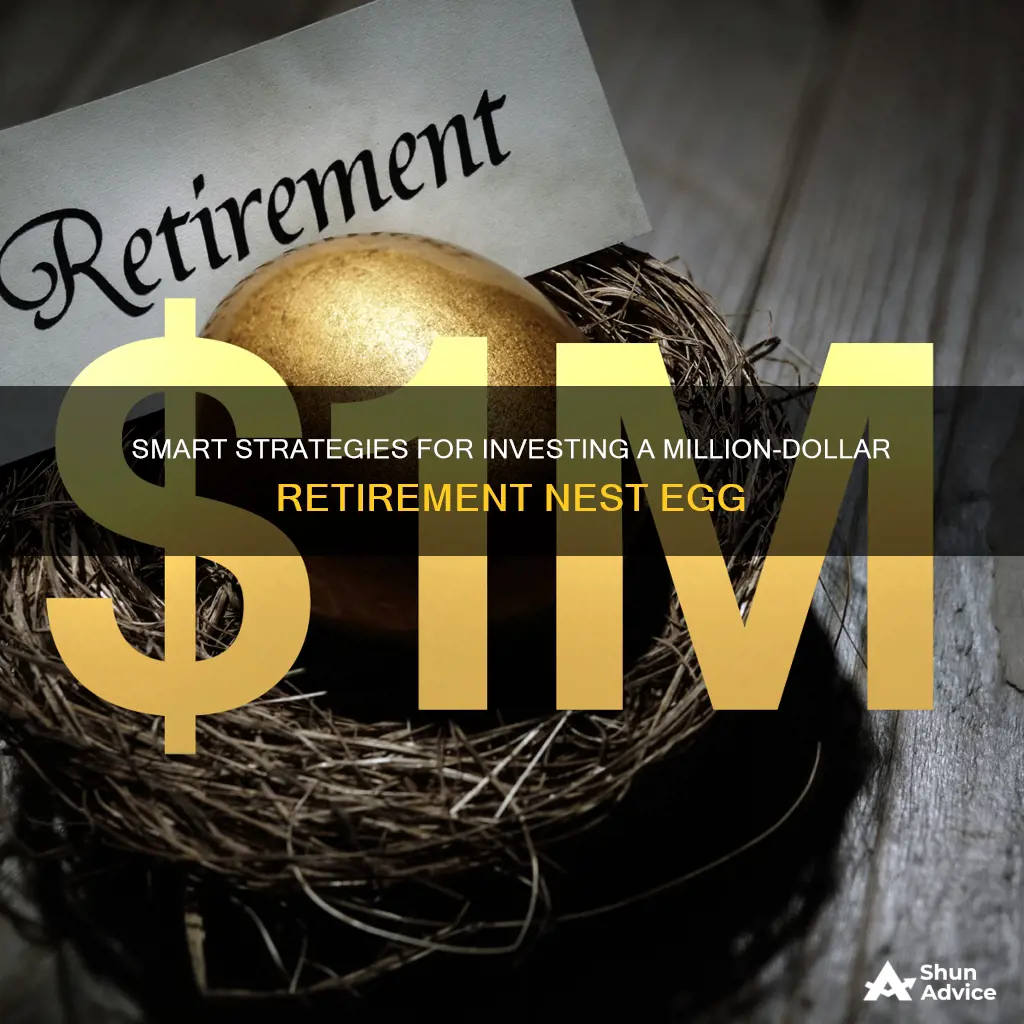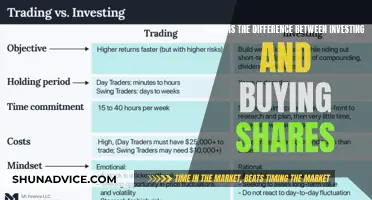
Investing $1 million once retired is a complex process that requires careful planning and consideration of various factors. While it may seem like a substantial sum, $1 million may not last as long as expected due to factors such as cost of living, lifestyle choices, healthcare expenses, and market volatility. To ensure a comfortable retirement, individuals should define their financial goals, risk tolerance, and time horizon. Seeking advice from financial professionals is recommended to navigate the risks and rewards of different investment options, such as stocks, bonds, real estate, and alternative assets. Additionally, understanding Social Security benefits and tax implications is crucial for effective retirement planning.
| Characteristics | Values |
|---|---|
| Retirement income | Social Security, pension, part-time work |
| Investment options | Annuities, traditional portfolio, real estate, alternative assets |
| Financial goals | Retirement, buying property, education savings, charitable contributions |
| Time horizon | Age, expected lifespan |
| Risk tolerance | Volatility, market downturns |
| Asset allocation | Stocks, bonds, cash alternatives, mutual funds, ETFs, dividend stocks, preferred stock, corporate bonds, municipal bonds, REITs |
| Expenses | Healthcare, lifestyle, inflation, taxes, cost of living |

Annuities: pros and cons
Annuities are a form of insurance against outliving your money, with the insurance company assuming the risk of you living too long. They can be a good option for retirees who want peace of mind and to ensure they never outlive their money. However, there are some pros and cons to consider before investing in an annuity.
Pros
An immediate annuity offers a guaranteed fixed-income stream for life. It is like buying a pension, where you exchange a lump sum for the insurance company's promise to pay you for the rest of your life. The amounts of these payments depend on prevailing interest rates and the retiree's life expectancy. The longer the retiree is expected to live, the lower the monthly payments. The checks will continue for as long as the retiree lives, even if they live past their life expectancy.
Cons
Annuities have two main disadvantages: tax treatment and illiquidity. Annuities are taxed at ordinary income rates, which can be higher than long-term capital gain rates for other investments. Additionally, owners are limited to their monthly checks and may not be able to withdraw a large sum without incurring penalties. The fixed payments may also not increase with interest rates, and there are often high upfront fees and surrender costs associated with annuities.
While annuities offer the security of a guaranteed income stream, they may not provide the same level of financial flexibility as investing in a traditional portfolio. It is important for retirees to consider their priorities and decide if having income for life or access to their full money is more important before investing in an annuity.
Analyzing Investment Opportunities: Strategies for Success
You may want to see also

Traditional investment portfolios
A traditional investment portfolio is typically diversified and includes mutual funds, stocks, and bonds. The Bucket Approach is a common strategy for constructing a retirement portfolio. This approach involves keeping assets needed for near-term living expenses in cash (Bucket 1), parking assets that won't be needed for several years in a diversified pool of long-term holdings (Bucket 2), and investing the remainder in stocks and high-risk bond funds (Bucket 3). Income and rebalancing proceeds from Buckets 2 and 3 are used to replenish Bucket 1 as it becomes depleted.
The main downside of traditional investment portfolios is the inability to project future market returns or inflation rates with certainty. A protracted bear market or a period of high inflation could cause a retiree's savings to deplete much faster than expected.
When investing in a traditional portfolio, it is important to consider your financial goals, timeline, and risk tolerance. Stocks, bonds, and alternative assets like real estate or commodities can all be part of a traditional portfolio, with the allocation depending on your goals, time horizon, and risk appetite.
Americans: Investors or Not?
You may want to see also

Stocks
Your equity investment can take many forms. If you have a high-risk tolerance, you might buy individual stocks. More risk-averse investors might opt for equity mutual funds or exchange-traded funds (ETFs).
There are two main types of stocks: growth stocks and value stocks. Growth stocks are companies that are rapidly expanding their revenue, profits, and cash flow at rates above the market average. Value stocks trade at prices that are much lower than their fundamentals suggest they are worth, due to issues in the market beyond the individual company's control.
Many companies also return profits to shareholders in the form of dividends. Dividend stocks offer double value to investors: income and the potential for share price appreciation. Preferred stocks always pay dividends, calculated as a percentage of the par value, and they offer greater protection for holders in the event of bankruptcy, so they are preferred by long-term investors.
Growth and value stocks are appropriate for more risk-tolerant investors, but each category tends to perform well in different types of markets. Therefore, investing in both makes sense for a well-rounded portfolio.
Investors who are more risk-averse or want to generate income from their investments might opt for dividend and preferred stocks, as they generate plenty of cash flow and also allow for gradual share price appreciation.
When investing in stocks, it is important to keep in mind that the stock market can be volatile, and there is always the risk of losing money. Diversifying your portfolio by investing in a variety of different stocks and other assets can help mitigate this risk.
Additionally, it is crucial to consider your overall financial goals and risk tolerance when deciding how much to invest in stocks. If you are investing for retirement, for example, you might want to take on less risk as you approach your retirement age.
Consulting a financial advisor can be helpful in determining how much of your $1 million to invest in stocks and which specific stocks to choose based on your unique circumstances and goals.
Task Investment: Navigating the World of Task Markets and Finance
You may want to see also

Bonds
Companies and governments issue bonds to borrow money. Bonds have a par value, and each issue has a specified maturity date and rate of interest, commonly called the coupon. Companies make coupon payments annually or semi-annually based on the interest rate and the par value. For example, a 5% coupon on a bond with a $1,000 par value will pay $50 per year. The borrower repays the principal on the bond's maturity date.
The lowest-risk bonds are issued by the U.S. Treasury and are available in maturities ranging from several weeks to 30 years. Since risk and return are directly proportional, lower-risk bonds have lower coupon rates. Bonds that are assigned credit ratings from agencies like Standard & Poor's and Moody's are called corporate bonds and are available at every point along the rating spectrum. Conservative investors usually stick with investment-grade bonds, while risk-on investors might opt for high-yield junk bonds.
Municipal bonds are issued by local or state governments to fund public projects. They are similar to other bonds, except that the interest income is usually free from federal and sometimes state income taxes. An investment in municipal bonds can improve a portfolio's tax efficiency.
When it comes to saving for retirement, investors generally use a combination of equity and fixed-income investments. If retirement is still far off, a portfolio is more likely to hold mostly equity investments because there is time to make up for any short-term fluctuations in the market. However, as retirement approaches, a portfolio's allocation should shift towards safer investments, such as bonds and other fixed-income securities.
- IShares Core U.S. Aggregate Bond ETF (AGG)
- Vanguard Total Bond Market ETF (BND)
- Fidelity U.S. Bond Index Fund (FXNAX)
- Vanguard Short-Term Corporate Bond ETF (VCSH)
- IShares Floating Rate Bond ETF (FLOT)
- Fidelity Investment Grade Bond Fund (FBNDX)
- Schwab U.S. Aggregate Bond Index Fund (SWAGX)
Investing in People: Country Strategies
You may want to see also

Real estate
Multifamily Real Estate Syndication
Investing in multifamily real estate is a great way to generate passive income. It involves multiple investors combining their funds to purchase a property, with a manager or sponsor handling the deal, transaction, financing, and management. This strategy provides stable income, strong returns, and tax advantages. It is also considered a recession-resilient asset class, as landlords can negotiate leases annually to keep pace with inflation.
Rental Properties
Investing in rental properties can provide annual returns of up to 9% or more. While the property appreciates, investors can generate income by renting it out. The value of leases tends to increase over time, even if the investor doesn't sell the property. The downside is the administrative burden of managing tenants, but this can be mitigated by hiring a property management company.
Fix and Flip Properties
Fix and flip properties involve purchasing real estate below market value, making repairs, and selling at a profit. This strategy can be risky, as it often involves high-interest, short-term loans, and is subject to market changes. However, it can be profitable with careful management and cosmetic upgrades.
Commercial Properties
Purchasing office, retail, or industrial buildings can be a profitable investment, often generating higher returns than residential properties. The value of these assets depends on factors such as the economy, location, and market conditions. Commercial properties have a longer depreciation window than multifamily properties, impacting tax advantages.
Private Lending
Becoming a private mortgage lender on a property allows you to create your own rules and generate income through interest on the loan. This option requires more knowledge and attention but gives you greater control over your investment.
REITs allow investors to pool their funds to participate in larger real estate projects without directly owning rental property. They provide liquidity and diversification but offer less control over your capital. It is important to choose a trustworthy fund to protect your assets.
When investing in real estate, it is crucial to consider your investment timeline and risk tolerance. Diversifying your portfolio across different asset classes and locations can help manage risk and maximize returns.
Unlocking Investment Opportunities: Understanding Principal Payments
You may want to see also
Frequently asked questions
It depends on several factors, including your desired retirement lifestyle, risk tolerance, health, and life expectancy. A recent analysis determined that $1 million in retirement savings may only last about 20 years depending on the state you live in.
This depends on your spending habits, investment choices, and inflation. If you invest wisely and live frugally, $1 million can last 30 or more years.
There are two main options: purchasing an immediate annuity or investing in a traditional portfolio. An annuity provides a guaranteed fixed income for life but has disadvantages like tax treatment and illiquidity. A traditional portfolio offers more flexibility and potentially higher returns but carries the risk of market volatility.
It depends on your risk tolerance and financial goals. If you want peace of mind and a guaranteed income stream, an annuity may be preferable. If you prioritize flexibility and access to your money, a traditional portfolio is a better option.
In addition to your risk tolerance and financial goals, consider your health and life expectancy, desired retirement lifestyle, cost of living, and potential income from sources like Social Security or part-time work.







